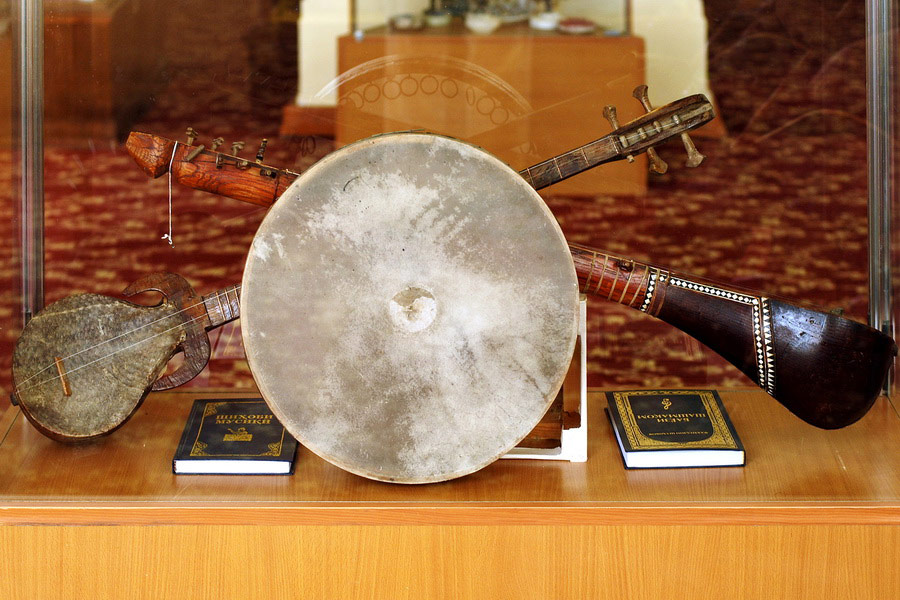 Musical Instruments
Musical Instruments
Tajik music beckons listeners with unusual melodies full of poetic mysticism which acquaint listeners with Tajik culture. Music in Tajikistan has been performed for at least two thousand years, and today there are multiple styles of music in the country which range from folk and classical music to modern pop songs.
History of Tajik Music
Tajik music was first mentioned in the Avesta (a collection of Zoroastrian religious texts written in the 6th-5th centuries BC) in reference to local ballads about mythical heroes. Findings also abound of terracotta figurines of musicians, wall hangings and images painted on dishes which depict musical scenes. Many of these were discovered during excavations around Samarkand, Penjikent and Termez and date to the 1st - 7th centuries AD. During the Middle Ages, miniatures portraying both solo musicians and entire ensembles were common throughout the region.
Oriental scholars have shed light on the history of music in Tajikistan with treatises such as Al-Farabi’s Big Book on Music (10th century) and Avicenna’s Treatise on Music (11th century). Scientific analyses of local music went on to influence authors in medieval Europe. Most notable among these were the 14th-15th century writings of Tajik authors Jami and Abdulgadir Maragi which outlined their studies of everything from local rhythms and scales to the acoustic properties of Tajik instruments and the effect of music on a person’s mental state. Scientists and poets of that time also created their own instruments, such as Avicenna’s gidjak.
Tajik Musical Instruments
As Tajikistan lived under the umbrella of Persian culture for centuries, many of its musical instruments were also common in Iran, Azerbaijan and even in neighboring non-Persian lands such as India. The most famous stringed instruments from Tajikistan are the dutar, tanbur, dumbrak and the Kashgar rubab. The most common Tajik wind instruments are the nai, karnay, kushnay and sunray, while percussion instruments include the doira, kairok, nabora and tablak. The panchtor, daf, blanzikom, tutuk and tetar (not to be confused with the Indian sitar) were also widespread in the Pamirs.
Tajik Folk Music
Tajik folk songs may be divided into Northern, Central and Pamiri styles, each of which possesses unique characteristics. The diversity of Tajik musical genres is much wider, encompassing ritual, calendar, labor, epic and lyrical songs.
Ritual songs were commonly sung at weddings, funerals, family events and special ceremonies. The Tajik song "Ustoi Langi Sartarosh", which translates as "Lame Hairdresser", was traditionally performed while preparing the groom for his wedding.
Calendar songs, many of which were performed by a male choir in unison, were sung during the holidays. Tajiks would celebrate Snowdrop Holiday, Tulip Holiday, Navruz and other spring observances with songs such as "Boychechak" (Snowdrop) and "Sayri Guli" (Tulip). As old traditions are revived in Tajikistan today, many of these folk songs can again be heard at the annual Sayri Guli Lola (Tulip Festival).
Tajik labor songs were sung while working in the field or performing chores at home. The most famous were "Maida", sung by the farmer while plowing his land, and the weaver's song "Ashulai bofan-da". "Garibi" songs, sung by men while leaving their home to search for work in large cities, only appeared in the 20th century.
Tajik lyrical songs have long been the most popular sector of Tajik music, with the theme of love always a favorite. One can hear maternal, romantic and humorous love songs, among many others.
Shashmaqom
Shashmaqom is a musical genre which originated in Central Asia and is held in high regard in both Tajik and Uzbek musical culture. The name “Shashmaqom” is a Persian term meaning six maqoms (modes), although maqom itself is a separate composition with its own scale. There was even a special twelve-maqom style called "Duvozdakhmaqom".
Shashmaqom officially formed in the 18th century, but many locals believe it already existed as a musical form in Tajikistan by the 11th century. Families would pass these songs from one generation to another through memorization and repetition alone.
Shashmaqom is traditionally performed by a choir of 5 musicians and 2-3 vocalists. The six parts of Shashmaqom include buzruk, rost, navo, dugokh, segoh and irok, each of which included an instrumental part (muskilot) and a vocal part (nasr). The instrumental part consists of the elements of tasnif, tarji, gardun, muhammas and sakil, while the vocal part contained a combination of sarakhbor, talkin, nasr, talkincha, kashkarcha, sokinoma, ufar and others. The works of famous Tajik poets such as Rudaki, Jami, Mushfiki and Bedil were often used as lyrics.
In 2003, UNESCO included Shashmaqom in the List of Masterpieces of the Oral and Intangible Cultural Heritage of Humanity from Tajikistan and Uzbekistan. Today this art is studied at the National Conservatory of Tajikistan in Dushanbe, Maqom Academy in Khujand and in Tashkent.
Tajik Music in the 20th Century
By the end of the 19th century, professional musical ensembles had become common in Tajikistan, including maqomists who performed Shashmaqom, sozanda female song-and-dance troupes and mavrigikhon musicians who performed songs related to Iranian culture.
After the Soviets rose to power in the 1920s, traditional European genres such as opera, ballet and symphonic music began to develop in Tajikistan. Musical institutions were opened and the first Tajik composers appeared. The first Tajik opera, "The Uprising of Vose", was presented to the public in 1939, and the first ballet ,"Two Roses", in 1941. In the second half of the 20th century, local composers began to insert elements of Tajik folklore into their compositions.
After the country gained independence in the late 20th century, music in Tajikistan started to absorb influences from rock, rap, pop, blues and other international genres. Some local performers have also gained popularity outside the borders of Tajikistan. Despite such changes, traditional Tajik music has not waned in popularity, and travelers to Tajikistan can also grow in appreciation for the unique forms of local music.

